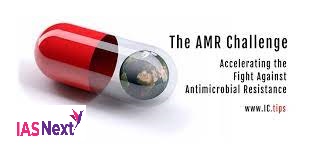CURRENT AFFAIRS
Get the most updated and recent current affair content on Padhaikaro.com
The challenge of antimicrobial resistance
- IAS NEXT, Lucknow
- 24, Jan 2022

Reference News:-
Global Research on Antimicrobial Resistance (GRAM) report recently published provides the most comprehensive estimate of the global impact of Antimicrobial resistance (AMR) so far.
What is Antimicrobial resistance?
Antimicrobial resistance (AMR) is a major public health threat where antibiotics are becoming ineffective because pathogens such as viruses, fungi and bacteria become resistant to them.
Do You know?
- Between 1980 and 2000, 63 new antibiotics were approved for clinical use. Between 2000 and 2018, just 15 additional antibiotics were approved.
- Out of the seven deadliest drug-resistant bacteria, vaccines are only available for two (Streptococcus pneumoniae and Mycobacterium tuberculosis).
What did the GRAM report find?
- As many as 4.95 million deaths may be associated with bacterial AMR in 2019.
- AMR is a leading cause of death globally, higher than HIV/AIDS or malaria.
- In South Asia, over 389,000 people died as a direct result of AMR in 2019.
- The death rate was the highest in Western sub-Saharan Africa, at 27.3 deaths per 100,000 and lowest in Australasia, at 6.5 deaths per 100,000.
- Lower respiratory-tract infections accounted for more than 1.5 million deaths associated with resistance in 2019, making it the most common infectious syndrome.
What are the implications of this study?
- Increased mortality: Common infections are now killing hundreds of thousands of people every year because bacteria have become resistant to treatment. This includes historically treatable illnesses, such as pneumonia, hospital-acquired infections, and foodborne ailments.
- Children at risk: Everyone is at risk from AMR, but the data shows that young children are particularly affected. In 2019, one in five global deaths attributable to AMR occurred in children under the age of five – often from previously treatable infections.
- Challenging Healthcare services: AMR is threatening the ability of hospitals to keep patients safe from infections and undermining the ability of doctors to carry out essential medical practice safely, including surgery, childbirth and cancer treatment since infection is a risk following these procedures.
What is the way forward?
- Better Monitoring: They recommend greater action to monitor and control infections, globally, nationally and within individual hospitals.
- Better access to basic necessities: Access to vaccines, clean water and sanitation ought to be expanded to be able to effectively tackle AMR.
- Optimising usage of antibiotics: The use of antibiotics unrelated to treating human disease, such as in food and animal production must be “optimised”
- It is recommended to be “more thoughtful” about the use of antimicrobial treatments – expanding access to lifesaving antibiotics where needed, minimising use where they are not necessary to improve human health
- Enhanced Funding: It is also recommend to increase funding for developing new antimicrobials and targeting priority pathogens such as K. pneumoniae and E. coli and ensuring that they are affordable to accessible to most of the world.